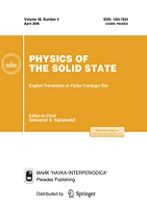|
This article is cited in 3 scientific papers (total in 3 papers)
Surface physics, thin films
On the gases adsorption on silicon carbide: simple estimates
S. Yu. Davydova, O. V. Posrednikb
a Ioffe Institute, St. Petersburg
b Saint Petersburg Electrotechnical University "LETI"
Abstract:
The adsorption of atomic and molecular nitrogen and ammonia on silicon carbide is considered within two physically different (solid-state and quantum-chemical) approaches. In the solid-state approach, the Haldane–Anderson model is used for the density of states of the SiC 4H and 6H polytypes to demonstrate that the energy of binding to the substrate is 6 and 3 eV for N atoms and N$_2$ molecule, respectively. In the quantum-chemical approach, the model of a surface diatomic molecule is used to find that the binding energy of atomic nitrogen is 6 and 4 eV for adsorption on the C- and Si-edges, respectively. It has been established that the charge transfer between an adsorbate and the substrate may be neglected in all the considered cases. It has been hypothesized that the dissociation of a molecule with the further passivation of its dangling $sp^3$-orbitals with hydrogen atoms takes place for silicon carbide as in the case of ammonia adsorption on Si(100).
Keywords:
Haldane–Anderson model, surface molecule model, charge transfer, adsorption energy.
Received: 19.03.2019
Revised: 19.03.2019
Accepted: 02.04.2019
Citation:
S. Yu. Davydov, O. V. Posrednik, “On the gases adsorption on silicon carbide: simple estimates”, Fizika Tverdogo Tela, 61:8 (2019), 1538–1541; Phys. Solid State, 61:8 (2019), 1490–1493
Linking options:
https://www.mathnet.ru/eng/ftt8740 https://www.mathnet.ru/eng/ftt/v61/i8/p1538
|


| Statistics & downloads: |
| Abstract page: | 55 | | Full-text PDF : | 31 |
|





 Contact us:
Contact us: Terms of Use
Terms of Use
 Registration to the website
Registration to the website Logotypes
Logotypes









 Citation in format
Citation in format 
